ICT352: Tier One Suppliers Insurance Group Automated System Report
VerifiedAdded on 2023/06/10
|15
|2822
|477
Report
AI Summary
This report presents a detailed project plan for Tier One Suppliers Insurance Group, focusing on the automation of their system to improve efficiency and attract more customers. The project aims to minimize data consumption and error rates, save time for agents, and properly manage customer risks. Key deliverables include data migration, tracking agent visits and conversations, and improving client processing. The project schedule outlines milestones, requirements, limits, and a work breakdown structure. Time and cost management are addressed using the Apportion method, with considerations for cloud costs, CRM licenses, and labor expenses. Resource management is handled through a RACI matrix, and risk management employs the Crawford Slip Method for risk identification and assessment. A communication management plan is also included to ensure effective stakeholder communication. This project plan serves as a comprehensive guide for implementing an automated system within the insurance group.
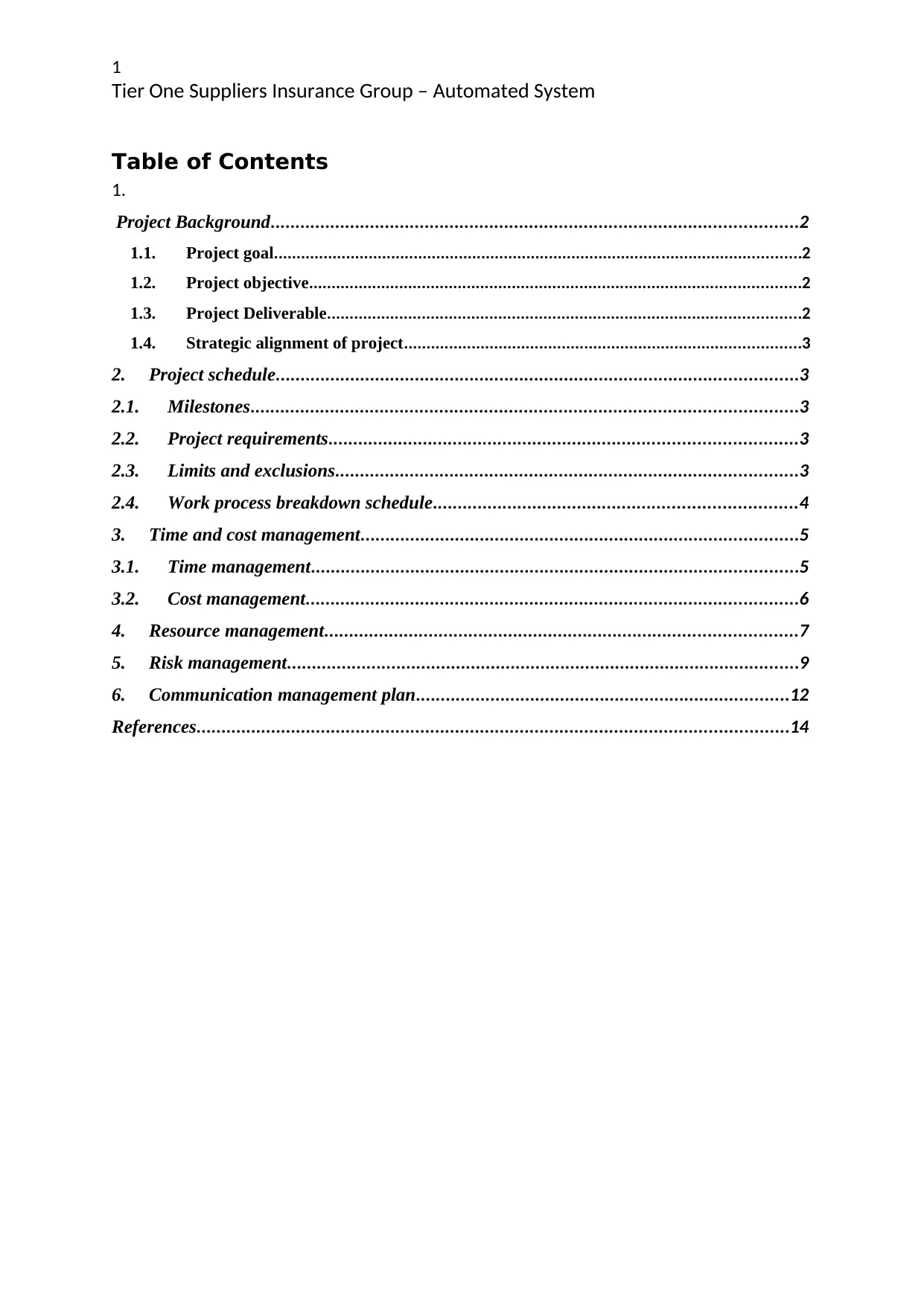
1
Tier One Suppliers Insurance Group – Automated System
Table of Contents
1.
Project Background..........................................................................................................2
1.1. Project goal.....................................................................................................................2
1.2. Project objective.............................................................................................................2
1.3. Project Deliverable.........................................................................................................2
1.4. Strategic alignment of project........................................................................................3
2. Project schedule.........................................................................................................3
2.1. Milestones..............................................................................................................3
2.2. Project requirements..............................................................................................3
2.3. Limits and exclusions.............................................................................................3
2.4. Work process breakdown schedule.........................................................................4
3. Time and cost management........................................................................................5
3.1. Time management..................................................................................................5
3.2. Cost management...................................................................................................6
4. Resource management...............................................................................................7
5. Risk management.......................................................................................................9
6. Communication management plan...........................................................................12
References.......................................................................................................................14
Tier One Suppliers Insurance Group – Automated System
Table of Contents
1.
Project Background..........................................................................................................2
1.1. Project goal.....................................................................................................................2
1.2. Project objective.............................................................................................................2
1.3. Project Deliverable.........................................................................................................2
1.4. Strategic alignment of project........................................................................................3
2. Project schedule.........................................................................................................3
2.1. Milestones..............................................................................................................3
2.2. Project requirements..............................................................................................3
2.3. Limits and exclusions.............................................................................................3
2.4. Work process breakdown schedule.........................................................................4
3. Time and cost management........................................................................................5
3.1. Time management..................................................................................................5
3.2. Cost management...................................................................................................6
4. Resource management...............................................................................................7
5. Risk management.......................................................................................................9
6. Communication management plan...........................................................................12
References.......................................................................................................................14
Paraphrase This Document
Need a fresh take? Get an instant paraphrase of this document with our AI Paraphraser
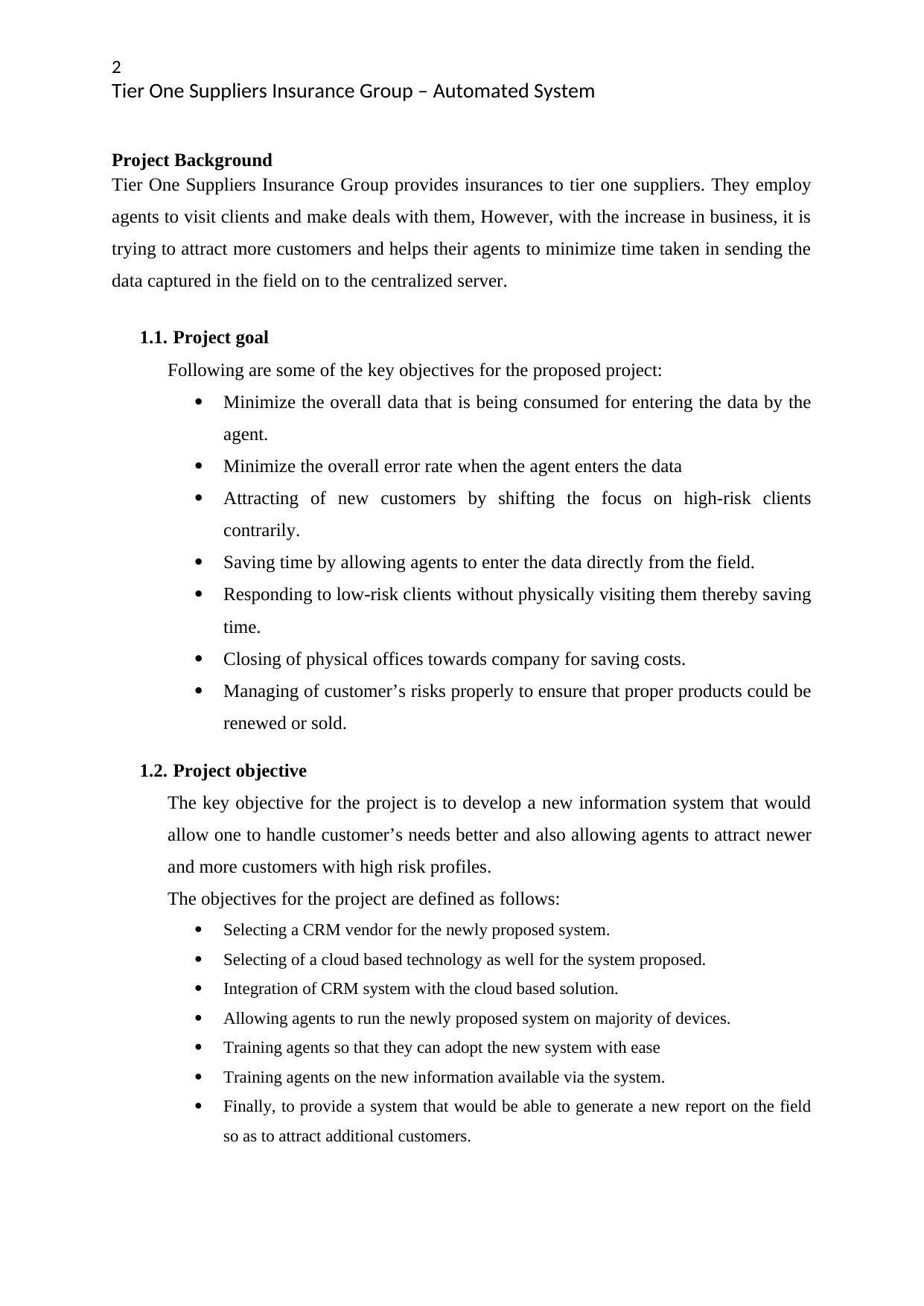
2
Tier One Suppliers Insurance Group – Automated System
Project Background
Tier One Suppliers Insurance Group provides insurances to tier one suppliers. They employ
agents to visit clients and make deals with them, However, with the increase in business, it is
trying to attract more customers and helps their agents to minimize time taken in sending the
data captured in the field on to the centralized server.
1.1. Project goal
Following are some of the key objectives for the proposed project:
Minimize the overall data that is being consumed for entering the data by the
agent.
Minimize the overall error rate when the agent enters the data
Attracting of new customers by shifting the focus on high-risk clients
contrarily.
Saving time by allowing agents to enter the data directly from the field.
Responding to low-risk clients without physically visiting them thereby saving
time.
Closing of physical offices towards company for saving costs.
Managing of customer’s risks properly to ensure that proper products could be
renewed or sold.
1.2. Project objective
The key objective for the project is to develop a new information system that would
allow one to handle customer’s needs better and also allowing agents to attract newer
and more customers with high risk profiles.
The objectives for the project are defined as follows:
Selecting a CRM vendor for the newly proposed system.
Selecting of a cloud based technology as well for the system proposed.
Integration of CRM system with the cloud based solution.
Allowing agents to run the newly proposed system on majority of devices.
Training agents so that they can adopt the new system with ease
Training agents on the new information available via the system.
Finally, to provide a system that would be able to generate a new report on the field
so as to attract additional customers.
Tier One Suppliers Insurance Group – Automated System
Project Background
Tier One Suppliers Insurance Group provides insurances to tier one suppliers. They employ
agents to visit clients and make deals with them, However, with the increase in business, it is
trying to attract more customers and helps their agents to minimize time taken in sending the
data captured in the field on to the centralized server.
1.1. Project goal
Following are some of the key objectives for the proposed project:
Minimize the overall data that is being consumed for entering the data by the
agent.
Minimize the overall error rate when the agent enters the data
Attracting of new customers by shifting the focus on high-risk clients
contrarily.
Saving time by allowing agents to enter the data directly from the field.
Responding to low-risk clients without physically visiting them thereby saving
time.
Closing of physical offices towards company for saving costs.
Managing of customer’s risks properly to ensure that proper products could be
renewed or sold.
1.2. Project objective
The key objective for the project is to develop a new information system that would
allow one to handle customer’s needs better and also allowing agents to attract newer
and more customers with high risk profiles.
The objectives for the project are defined as follows:
Selecting a CRM vendor for the newly proposed system.
Selecting of a cloud based technology as well for the system proposed.
Integration of CRM system with the cloud based solution.
Allowing agents to run the newly proposed system on majority of devices.
Training agents so that they can adopt the new system with ease
Training agents on the new information available via the system.
Finally, to provide a system that would be able to generate a new report on the field
so as to attract additional customers.
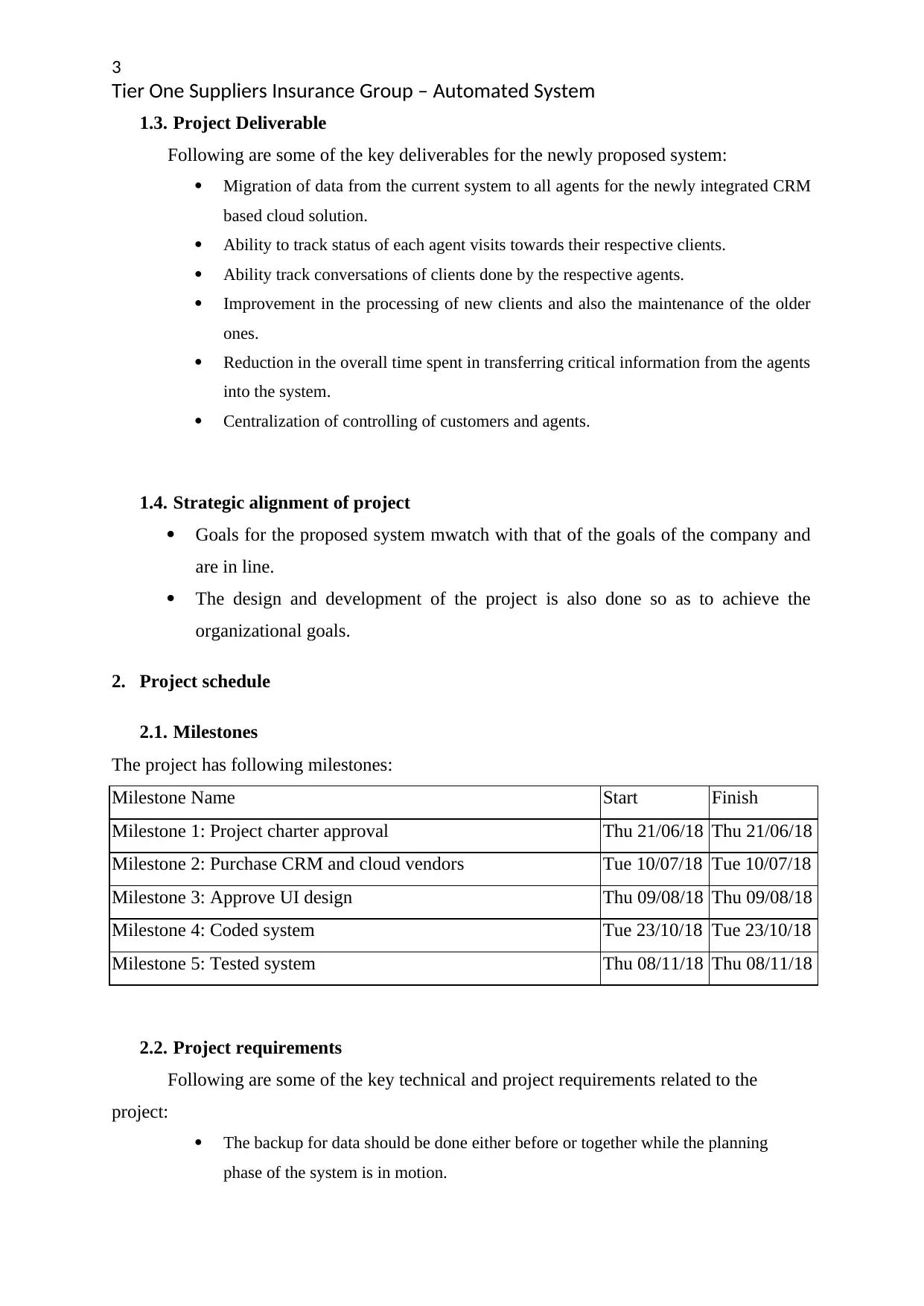
3
Tier One Suppliers Insurance Group – Automated System
1.3. Project Deliverable
Following are some of the key deliverables for the newly proposed system:
Migration of data from the current system to all agents for the newly integrated CRM
based cloud solution.
Ability to track status of each agent visits towards their respective clients.
Ability track conversations of clients done by the respective agents.
Improvement in the processing of new clients and also the maintenance of the older
ones.
Reduction in the overall time spent in transferring critical information from the agents
into the system.
Centralization of controlling of customers and agents.
1.4. Strategic alignment of project
Goals for the proposed system mwatch with that of the goals of the company and
are in line.
The design and development of the project is also done so as to achieve the
organizational goals.
2. Project schedule
2.1. Milestones
The project has following milestones:
Milestone Name Start Finish
Milestone 1: Project charter approval Thu 21/06/18 Thu 21/06/18
Milestone 2: Purchase CRM and cloud vendors Tue 10/07/18 Tue 10/07/18
Milestone 3: Approve UI design Thu 09/08/18 Thu 09/08/18
Milestone 4: Coded system Tue 23/10/18 Tue 23/10/18
Milestone 5: Tested system Thu 08/11/18 Thu 08/11/18
2.2. Project requirements
Following are some of the key technical and project requirements related to the
project:
The backup for data should be done either before or together while the planning
phase of the system is in motion.
Tier One Suppliers Insurance Group – Automated System
1.3. Project Deliverable
Following are some of the key deliverables for the newly proposed system:
Migration of data from the current system to all agents for the newly integrated CRM
based cloud solution.
Ability to track status of each agent visits towards their respective clients.
Ability track conversations of clients done by the respective agents.
Improvement in the processing of new clients and also the maintenance of the older
ones.
Reduction in the overall time spent in transferring critical information from the agents
into the system.
Centralization of controlling of customers and agents.
1.4. Strategic alignment of project
Goals for the proposed system mwatch with that of the goals of the company and
are in line.
The design and development of the project is also done so as to achieve the
organizational goals.
2. Project schedule
2.1. Milestones
The project has following milestones:
Milestone Name Start Finish
Milestone 1: Project charter approval Thu 21/06/18 Thu 21/06/18
Milestone 2: Purchase CRM and cloud vendors Tue 10/07/18 Tue 10/07/18
Milestone 3: Approve UI design Thu 09/08/18 Thu 09/08/18
Milestone 4: Coded system Tue 23/10/18 Tue 23/10/18
Milestone 5: Tested system Thu 08/11/18 Thu 08/11/18
2.2. Project requirements
Following are some of the key technical and project requirements related to the
project:
The backup for data should be done either before or together while the planning
phase of the system is in motion.
⊘ This is a preview!⊘
Do you want full access?
Subscribe today to unlock all pages.

Trusted by 1+ million students worldwide
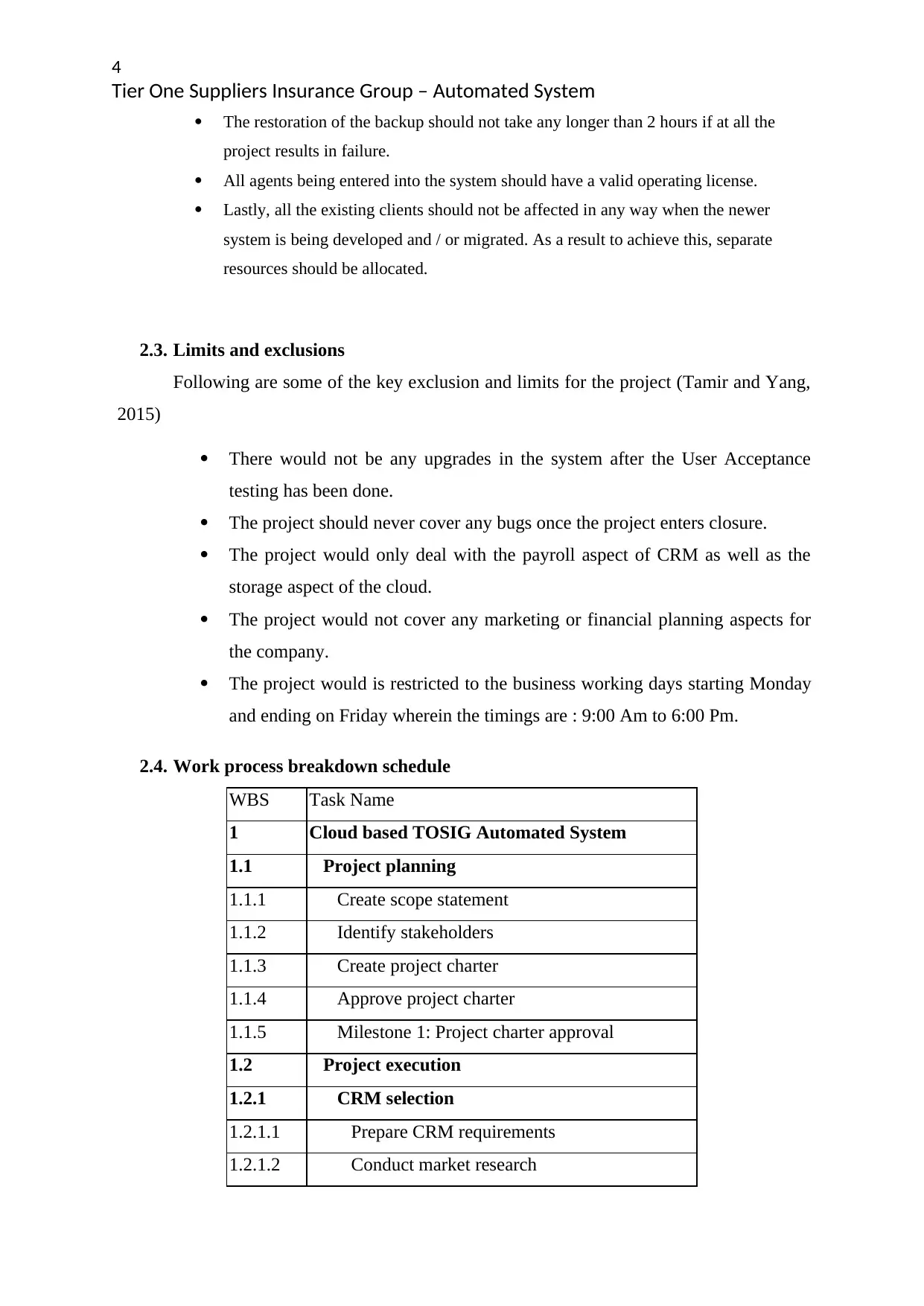
4
Tier One Suppliers Insurance Group – Automated System
The restoration of the backup should not take any longer than 2 hours if at all the
project results in failure.
All agents being entered into the system should have a valid operating license.
Lastly, all the existing clients should not be affected in any way when the newer
system is being developed and / or migrated. As a result to achieve this, separate
resources should be allocated.
2.3. Limits and exclusions
Following are some of the key exclusion and limits for the project (Tamir and Yang,
2015)
There would not be any upgrades in the system after the User Acceptance
testing has been done.
The project should never cover any bugs once the project enters closure.
The project would only deal with the payroll aspect of CRM as well as the
storage aspect of the cloud.
The project would not cover any marketing or financial planning aspects for
the company.
The project would is restricted to the business working days starting Monday
and ending on Friday wherein the timings are : 9:00 Am to 6:00 Pm.
2.4. Work process breakdown schedule
WBS Task Name
1 Cloud based TOSIG Automated System
1.1 Project planning
1.1.1 Create scope statement
1.1.2 Identify stakeholders
1.1.3 Create project charter
1.1.4 Approve project charter
1.1.5 Milestone 1: Project charter approval
1.2 Project execution
1.2.1 CRM selection
1.2.1.1 Prepare CRM requirements
1.2.1.2 Conduct market research
Tier One Suppliers Insurance Group – Automated System
The restoration of the backup should not take any longer than 2 hours if at all the
project results in failure.
All agents being entered into the system should have a valid operating license.
Lastly, all the existing clients should not be affected in any way when the newer
system is being developed and / or migrated. As a result to achieve this, separate
resources should be allocated.
2.3. Limits and exclusions
Following are some of the key exclusion and limits for the project (Tamir and Yang,
2015)
There would not be any upgrades in the system after the User Acceptance
testing has been done.
The project should never cover any bugs once the project enters closure.
The project would only deal with the payroll aspect of CRM as well as the
storage aspect of the cloud.
The project would not cover any marketing or financial planning aspects for
the company.
The project would is restricted to the business working days starting Monday
and ending on Friday wherein the timings are : 9:00 Am to 6:00 Pm.
2.4. Work process breakdown schedule
WBS Task Name
1 Cloud based TOSIG Automated System
1.1 Project planning
1.1.1 Create scope statement
1.1.2 Identify stakeholders
1.1.3 Create project charter
1.1.4 Approve project charter
1.1.5 Milestone 1: Project charter approval
1.2 Project execution
1.2.1 CRM selection
1.2.1.1 Prepare CRM requirements
1.2.1.2 Conduct market research
Paraphrase This Document
Need a fresh take? Get an instant paraphrase of this document with our AI Paraphraser
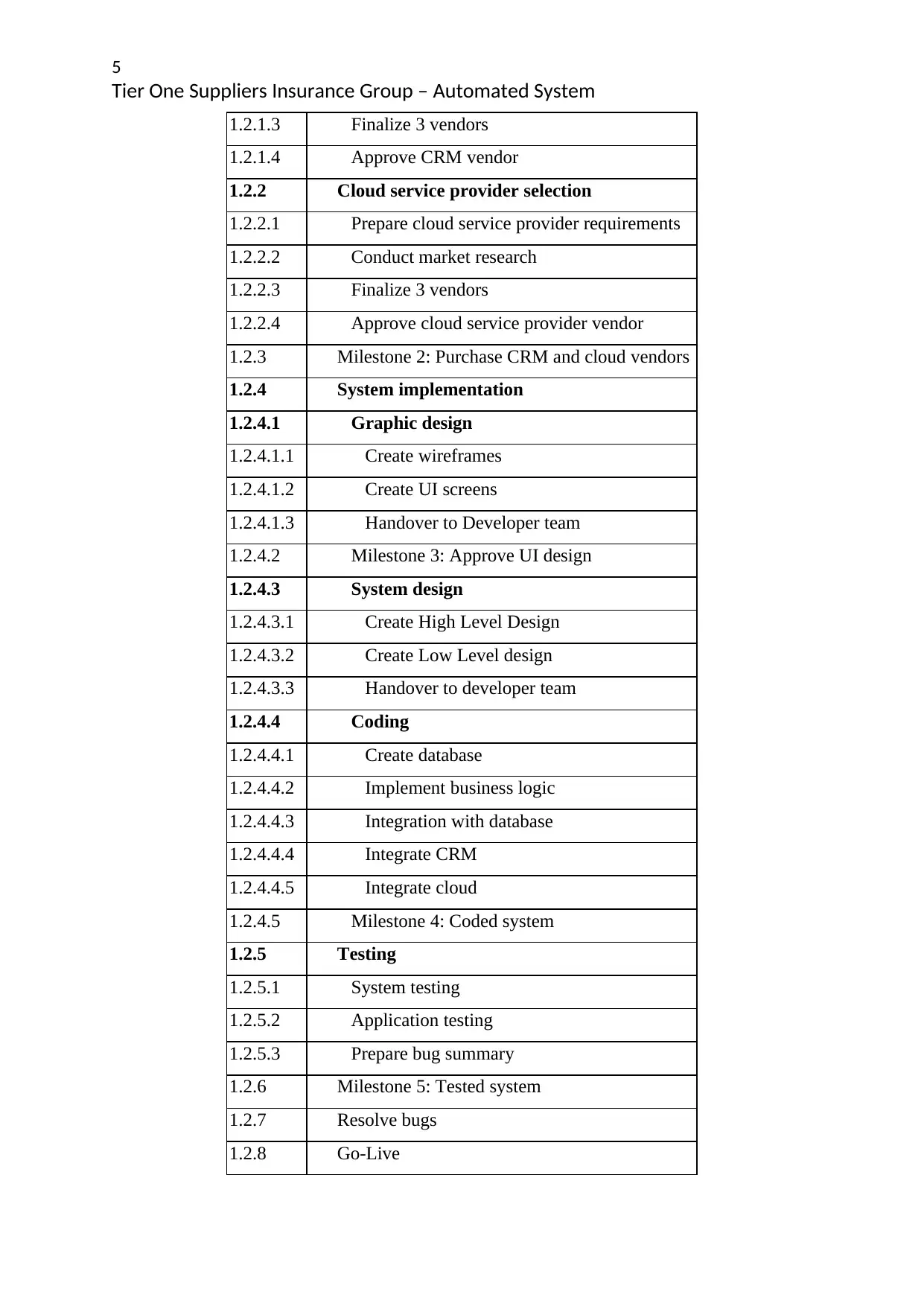
5
Tier One Suppliers Insurance Group – Automated System
1.2.1.3 Finalize 3 vendors
1.2.1.4 Approve CRM vendor
1.2.2 Cloud service provider selection
1.2.2.1 Prepare cloud service provider requirements
1.2.2.2 Conduct market research
1.2.2.3 Finalize 3 vendors
1.2.2.4 Approve cloud service provider vendor
1.2.3 Milestone 2: Purchase CRM and cloud vendors
1.2.4 System implementation
1.2.4.1 Graphic design
1.2.4.1.1 Create wireframes
1.2.4.1.2 Create UI screens
1.2.4.1.3 Handover to Developer team
1.2.4.2 Milestone 3: Approve UI design
1.2.4.3 System design
1.2.4.3.1 Create High Level Design
1.2.4.3.2 Create Low Level design
1.2.4.3.3 Handover to developer team
1.2.4.4 Coding
1.2.4.4.1 Create database
1.2.4.4.2 Implement business logic
1.2.4.4.3 Integration with database
1.2.4.4.4 Integrate CRM
1.2.4.4.5 Integrate cloud
1.2.4.5 Milestone 4: Coded system
1.2.5 Testing
1.2.5.1 System testing
1.2.5.2 Application testing
1.2.5.3 Prepare bug summary
1.2.6 Milestone 5: Tested system
1.2.7 Resolve bugs
1.2.8 Go-Live
Tier One Suppliers Insurance Group – Automated System
1.2.1.3 Finalize 3 vendors
1.2.1.4 Approve CRM vendor
1.2.2 Cloud service provider selection
1.2.2.1 Prepare cloud service provider requirements
1.2.2.2 Conduct market research
1.2.2.3 Finalize 3 vendors
1.2.2.4 Approve cloud service provider vendor
1.2.3 Milestone 2: Purchase CRM and cloud vendors
1.2.4 System implementation
1.2.4.1 Graphic design
1.2.4.1.1 Create wireframes
1.2.4.1.2 Create UI screens
1.2.4.1.3 Handover to Developer team
1.2.4.2 Milestone 3: Approve UI design
1.2.4.3 System design
1.2.4.3.1 Create High Level Design
1.2.4.3.2 Create Low Level design
1.2.4.3.3 Handover to developer team
1.2.4.4 Coding
1.2.4.4.1 Create database
1.2.4.4.2 Implement business logic
1.2.4.4.3 Integration with database
1.2.4.4.4 Integrate CRM
1.2.4.4.5 Integrate cloud
1.2.4.5 Milestone 4: Coded system
1.2.5 Testing
1.2.5.1 System testing
1.2.5.2 Application testing
1.2.5.3 Prepare bug summary
1.2.6 Milestone 5: Tested system
1.2.7 Resolve bugs
1.2.8 Go-Live
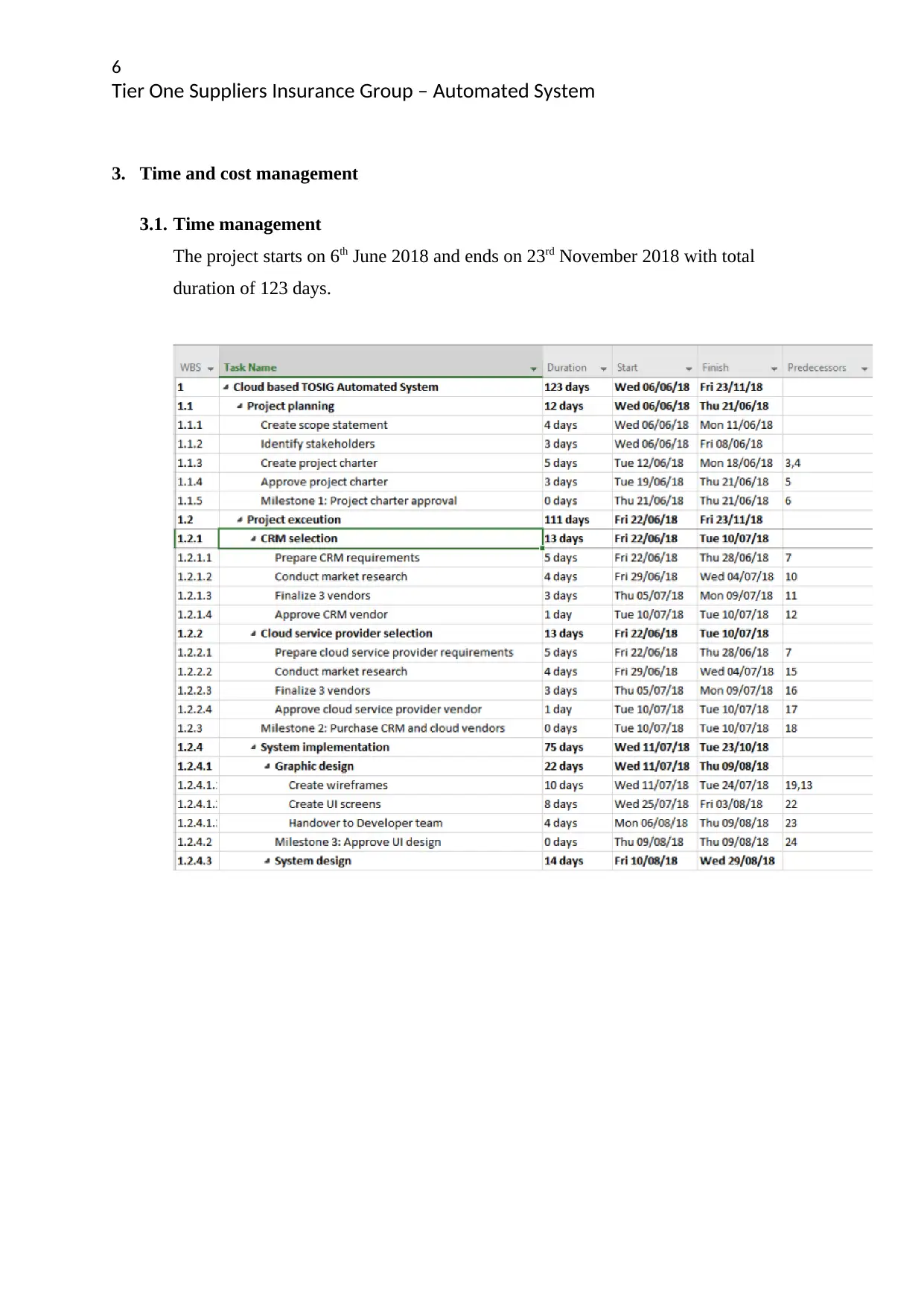
6
Tier One Suppliers Insurance Group – Automated System
3. Time and cost management
3.1. Time management
The project starts on 6th June 2018 and ends on 23rd November 2018 with total
duration of 123 days.
Tier One Suppliers Insurance Group – Automated System
3. Time and cost management
3.1. Time management
The project starts on 6th June 2018 and ends on 23rd November 2018 with total
duration of 123 days.
⊘ This is a preview!⊘
Do you want full access?
Subscribe today to unlock all pages.

Trusted by 1+ million students worldwide
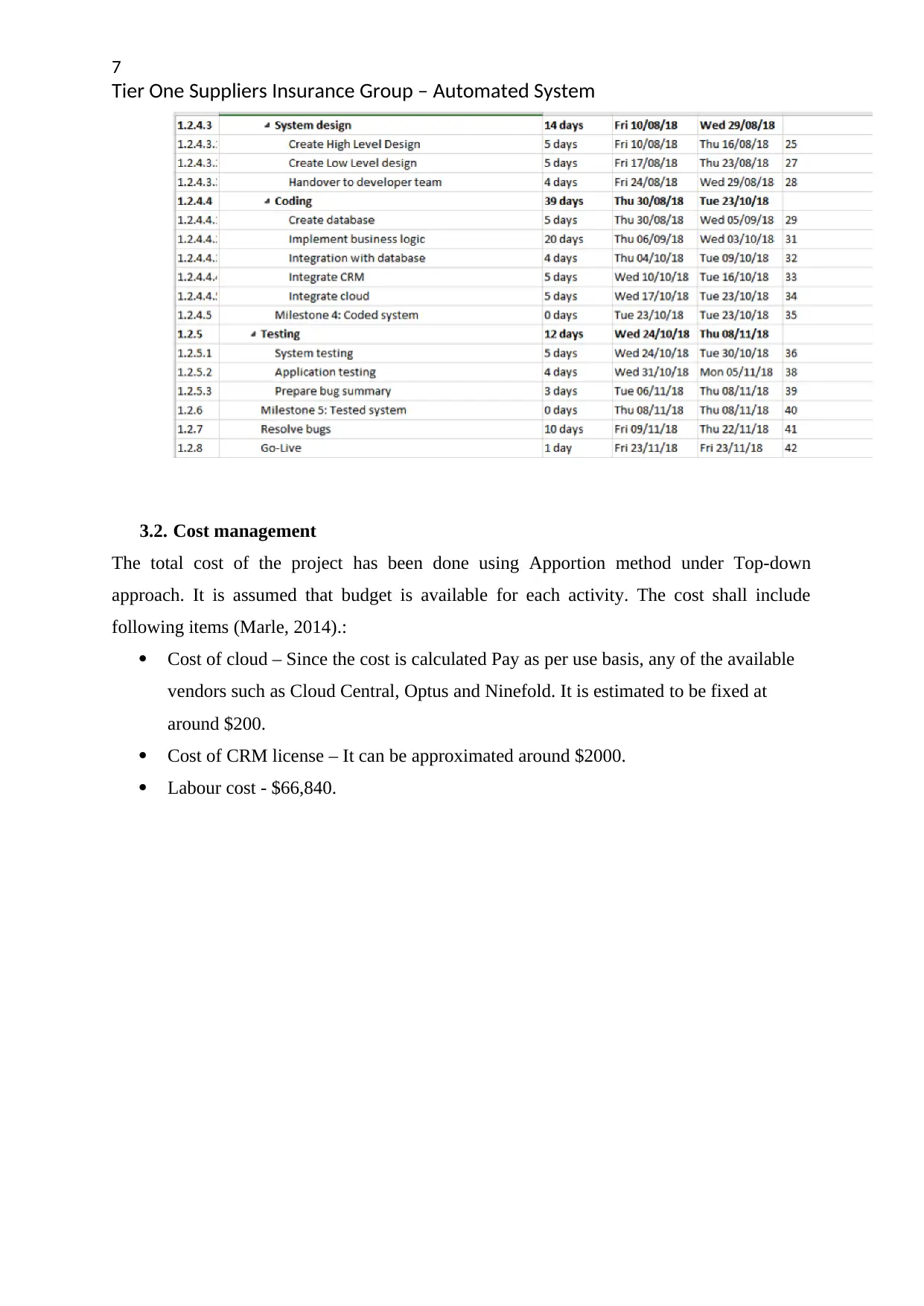
7
Tier One Suppliers Insurance Group – Automated System
3.2. Cost management
The total cost of the project has been done using Apportion method under Top-down
approach. It is assumed that budget is available for each activity. The cost shall include
following items (Marle, 2014).:
Cost of cloud – Since the cost is calculated Pay as per use basis, any of the available
vendors such as Cloud Central, Optus and Ninefold. It is estimated to be fixed at
around $200.
Cost of CRM license – It can be approximated around $2000.
Labour cost - $66,840.
Tier One Suppliers Insurance Group – Automated System
3.2. Cost management
The total cost of the project has been done using Apportion method under Top-down
approach. It is assumed that budget is available for each activity. The cost shall include
following items (Marle, 2014).:
Cost of cloud – Since the cost is calculated Pay as per use basis, any of the available
vendors such as Cloud Central, Optus and Ninefold. It is estimated to be fixed at
around $200.
Cost of CRM license – It can be approximated around $2000.
Labour cost - $66,840.
Paraphrase This Document
Need a fresh take? Get an instant paraphrase of this document with our AI Paraphraser
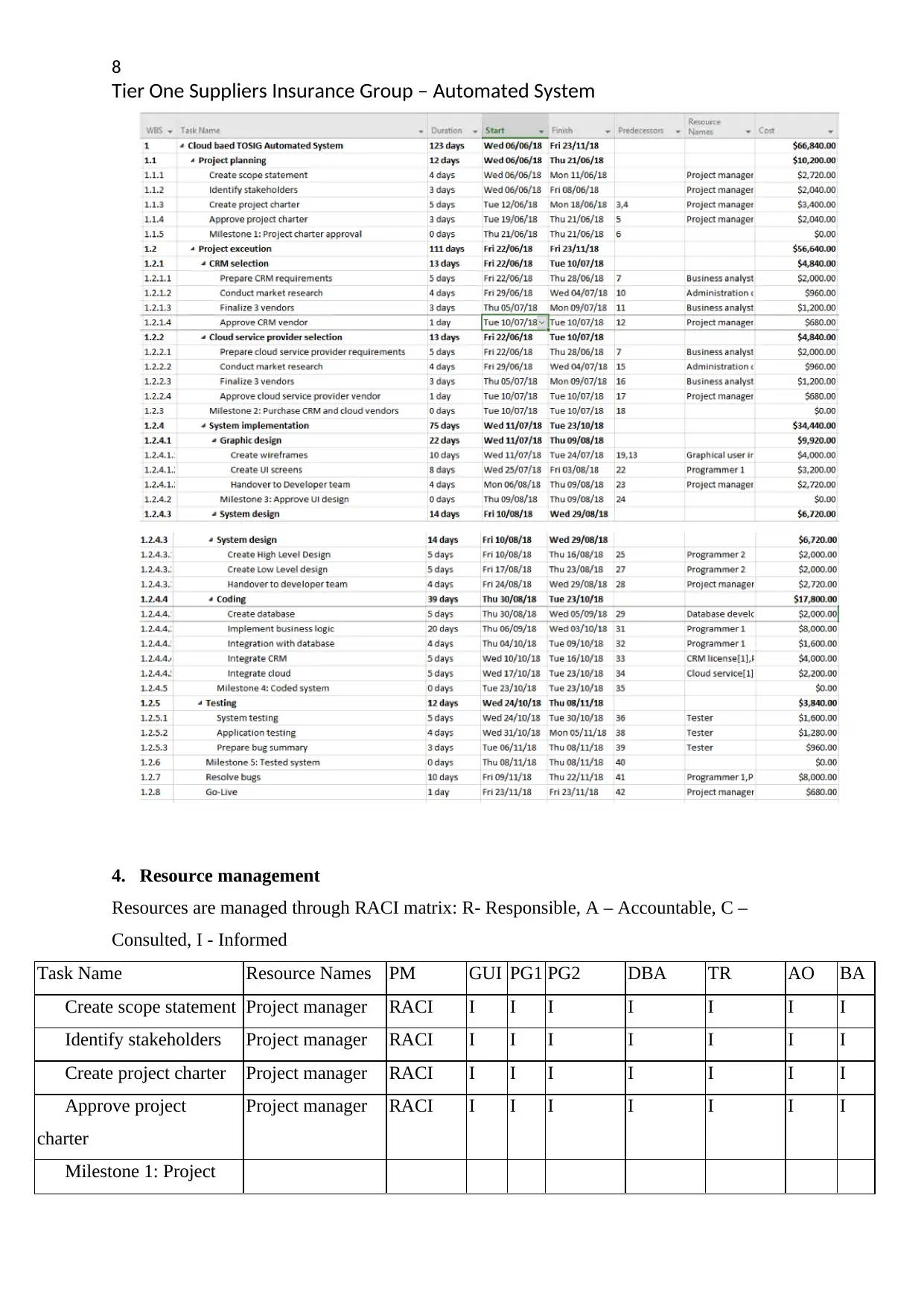
8
Tier One Suppliers Insurance Group – Automated System
4. Resource management
Resources are managed through RACI matrix: R- Responsible, A – Accountable, C –
Consulted, I - Informed
Task Name Resource Names PM GUI PG1 PG2 DBA TR AO BA
Create scope statement Project manager RACI I I I I I I I
Identify stakeholders Project manager RACI I I I I I I I
Create project charter Project manager RACI I I I I I I I
Approve project
charter
Project manager RACI I I I I I I I
Milestone 1: Project
Tier One Suppliers Insurance Group – Automated System
4. Resource management
Resources are managed through RACI matrix: R- Responsible, A – Accountable, C –
Consulted, I - Informed
Task Name Resource Names PM GUI PG1 PG2 DBA TR AO BA
Create scope statement Project manager RACI I I I I I I I
Identify stakeholders Project manager RACI I I I I I I I
Create project charter Project manager RACI I I I I I I I
Approve project
charter
Project manager RACI I I I I I I I
Milestone 1: Project
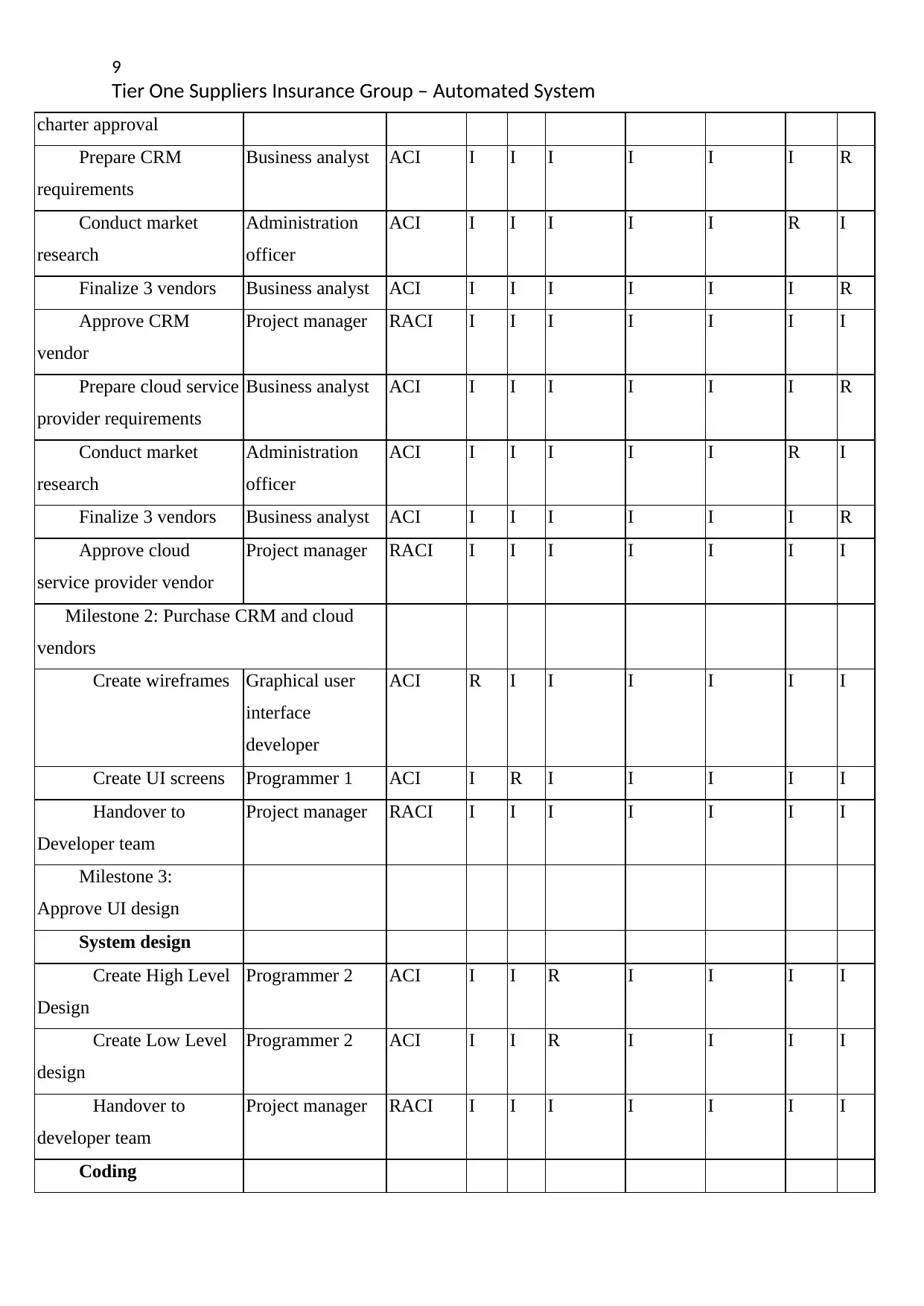
9
Tier One Suppliers Insurance Group – Automated System
charter approval
Prepare CRM
requirements
Business analyst ACI I I I I I I R
Conduct market
research
Administration
officer
ACI I I I I I R I
Finalize 3 vendors Business analyst ACI I I I I I I R
Approve CRM
vendor
Project manager RACI I I I I I I I
Prepare cloud service
provider requirements
Business analyst ACI I I I I I I R
Conduct market
research
Administration
officer
ACI I I I I I R I
Finalize 3 vendors Business analyst ACI I I I I I I R
Approve cloud
service provider vendor
Project manager RACI I I I I I I I
Milestone 2: Purchase CRM and cloud
vendors
Create wireframes Graphical user
interface
developer
ACI R I I I I I I
Create UI screens Programmer 1 ACI I R I I I I I
Handover to
Developer team
Project manager RACI I I I I I I I
Milestone 3:
Approve UI design
System design
Create High Level
Design
Programmer 2 ACI I I R I I I I
Create Low Level
design
Programmer 2 ACI I I R I I I I
Handover to
developer team
Project manager RACI I I I I I I I
Coding
Tier One Suppliers Insurance Group – Automated System
charter approval
Prepare CRM
requirements
Business analyst ACI I I I I I I R
Conduct market
research
Administration
officer
ACI I I I I I R I
Finalize 3 vendors Business analyst ACI I I I I I I R
Approve CRM
vendor
Project manager RACI I I I I I I I
Prepare cloud service
provider requirements
Business analyst ACI I I I I I I R
Conduct market
research
Administration
officer
ACI I I I I I R I
Finalize 3 vendors Business analyst ACI I I I I I I R
Approve cloud
service provider vendor
Project manager RACI I I I I I I I
Milestone 2: Purchase CRM and cloud
vendors
Create wireframes Graphical user
interface
developer
ACI R I I I I I I
Create UI screens Programmer 1 ACI I R I I I I I
Handover to
Developer team
Project manager RACI I I I I I I I
Milestone 3:
Approve UI design
System design
Create High Level
Design
Programmer 2 ACI I I R I I I I
Create Low Level
design
Programmer 2 ACI I I R I I I I
Handover to
developer team
Project manager RACI I I I I I I I
Coding
⊘ This is a preview!⊘
Do you want full access?
Subscribe today to unlock all pages.

Trusted by 1+ million students worldwide
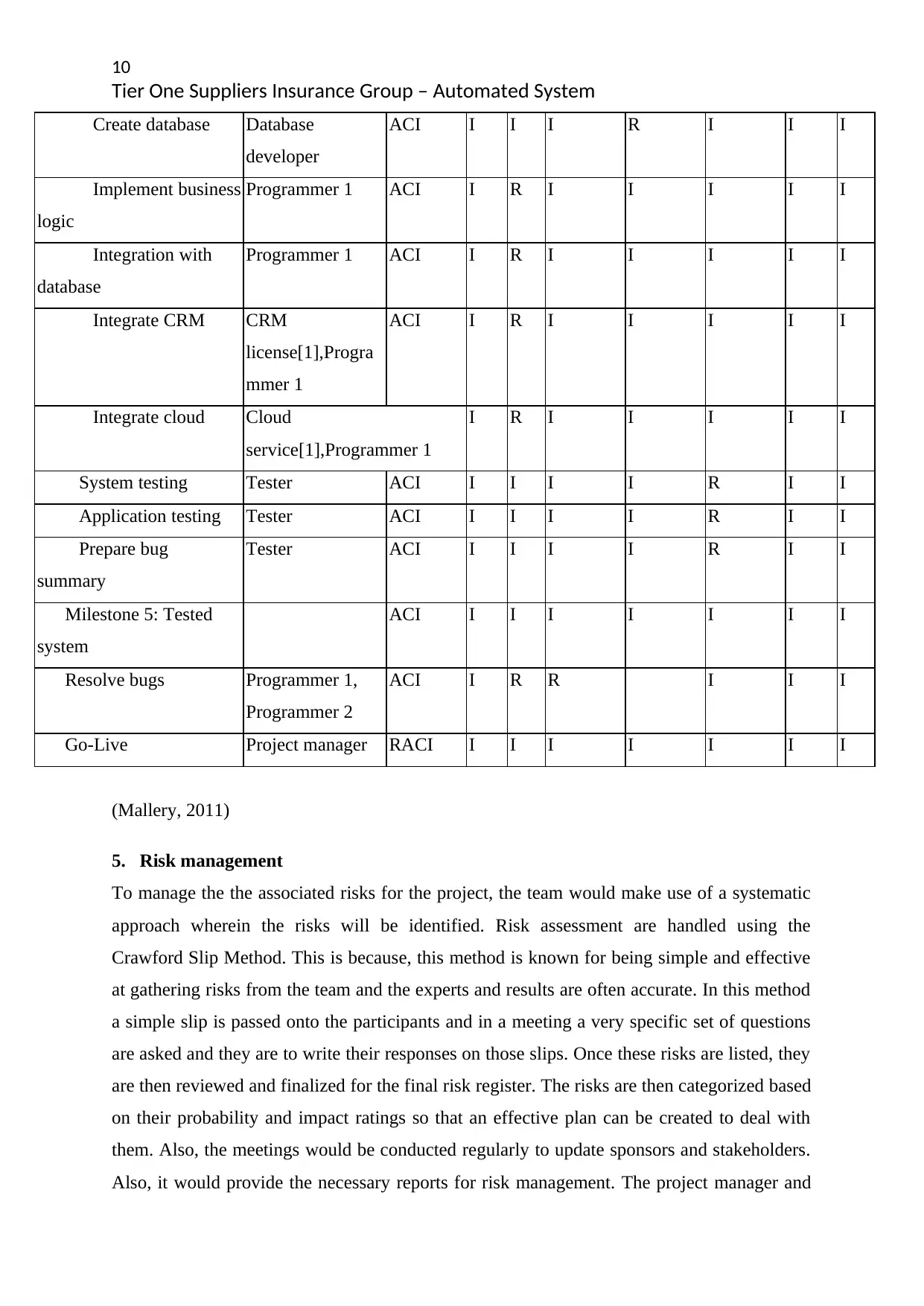
10
Tier One Suppliers Insurance Group – Automated System
Create database Database
developer
ACI I I I R I I I
Implement business
logic
Programmer 1 ACI I R I I I I I
Integration with
database
Programmer 1 ACI I R I I I I I
Integrate CRM CRM
license[1],Progra
mmer 1
ACI I R I I I I I
Integrate cloud Cloud
service[1],Programmer 1
I R I I I I I
System testing Tester ACI I I I I R I I
Application testing Tester ACI I I I I R I I
Prepare bug
summary
Tester ACI I I I I R I I
Milestone 5: Tested
system
ACI I I I I I I I
Resolve bugs Programmer 1,
Programmer 2
ACI I R R I I I
Go-Live Project manager RACI I I I I I I I
(Mallery, 2011)
5. Risk management
To manage the the associated risks for the project, the team would make use of a systematic
approach wherein the risks will be identified. Risk assessment are handled using the
Crawford Slip Method. This is because, this method is known for being simple and effective
at gathering risks from the team and the experts and results are often accurate. In this method
a simple slip is passed onto the participants and in a meeting a very specific set of questions
are asked and they are to write their responses on those slips. Once these risks are listed, they
are then reviewed and finalized for the final risk register. The risks are then categorized based
on their probability and impact ratings so that an effective plan can be created to deal with
them. Also, the meetings would be conducted regularly to update sponsors and stakeholders.
Also, it would provide the necessary reports for risk management. The project manager and
Tier One Suppliers Insurance Group – Automated System
Create database Database
developer
ACI I I I R I I I
Implement business
logic
Programmer 1 ACI I R I I I I I
Integration with
database
Programmer 1 ACI I R I I I I I
Integrate CRM CRM
license[1],Progra
mmer 1
ACI I R I I I I I
Integrate cloud Cloud
service[1],Programmer 1
I R I I I I I
System testing Tester ACI I I I I R I I
Application testing Tester ACI I I I I R I I
Prepare bug
summary
Tester ACI I I I I R I I
Milestone 5: Tested
system
ACI I I I I I I I
Resolve bugs Programmer 1,
Programmer 2
ACI I R R I I I
Go-Live Project manager RACI I I I I I I I
(Mallery, 2011)
5. Risk management
To manage the the associated risks for the project, the team would make use of a systematic
approach wherein the risks will be identified. Risk assessment are handled using the
Crawford Slip Method. This is because, this method is known for being simple and effective
at gathering risks from the team and the experts and results are often accurate. In this method
a simple slip is passed onto the participants and in a meeting a very specific set of questions
are asked and they are to write their responses on those slips. Once these risks are listed, they
are then reviewed and finalized for the final risk register. The risks are then categorized based
on their probability and impact ratings so that an effective plan can be created to deal with
them. Also, the meetings would be conducted regularly to update sponsors and stakeholders.
Also, it would provide the necessary reports for risk management. The project manager and
Paraphrase This Document
Need a fresh take? Get an instant paraphrase of this document with our AI Paraphraser
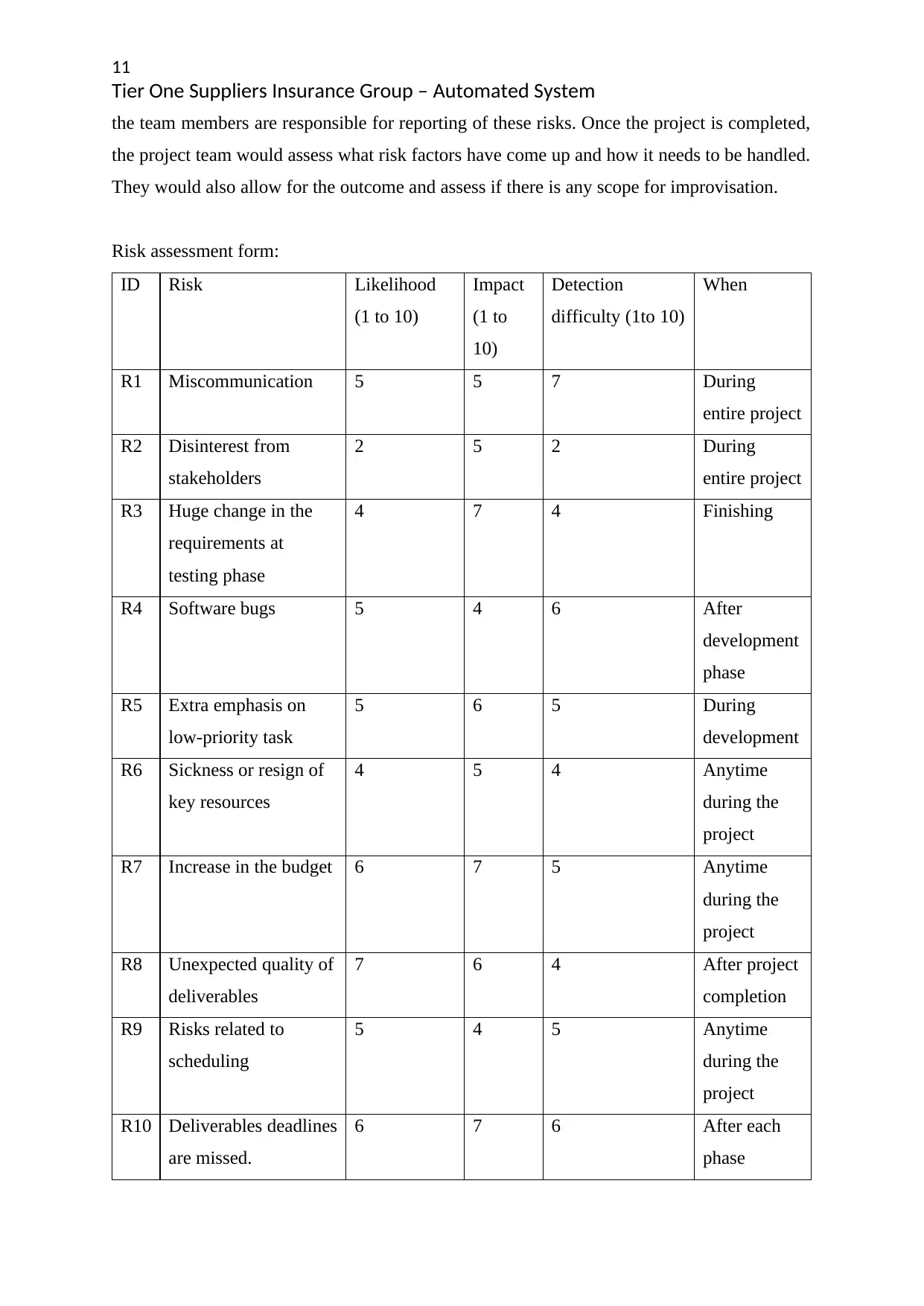
11
Tier One Suppliers Insurance Group – Automated System
the team members are responsible for reporting of these risks. Once the project is completed,
the project team would assess what risk factors have come up and how it needs to be handled.
They would also allow for the outcome and assess if there is any scope for improvisation.
Risk assessment form:
ID Risk Likelihood
(1 to 10)
Impact
(1 to
10)
Detection
difficulty (1to 10)
When
R1 Miscommunication 5 5 7 During
entire project
R2 Disinterest from
stakeholders
2 5 2 During
entire project
R3 Huge change in the
requirements at
testing phase
4 7 4 Finishing
R4 Software bugs 5 4 6 After
development
phase
R5 Extra emphasis on
low-priority task
5 6 5 During
development
R6 Sickness or resign of
key resources
4 5 4 Anytime
during the
project
R7 Increase in the budget 6 7 5 Anytime
during the
project
R8 Unexpected quality of
deliverables
7 6 4 After project
completion
R9 Risks related to
scheduling
5 4 5 Anytime
during the
project
R10 Deliverables deadlines
are missed.
6 7 6 After each
phase
Tier One Suppliers Insurance Group – Automated System
the team members are responsible for reporting of these risks. Once the project is completed,
the project team would assess what risk factors have come up and how it needs to be handled.
They would also allow for the outcome and assess if there is any scope for improvisation.
Risk assessment form:
ID Risk Likelihood
(1 to 10)
Impact
(1 to
10)
Detection
difficulty (1to 10)
When
R1 Miscommunication 5 5 7 During
entire project
R2 Disinterest from
stakeholders
2 5 2 During
entire project
R3 Huge change in the
requirements at
testing phase
4 7 4 Finishing
R4 Software bugs 5 4 6 After
development
phase
R5 Extra emphasis on
low-priority task
5 6 5 During
development
R6 Sickness or resign of
key resources
4 5 4 Anytime
during the
project
R7 Increase in the budget 6 7 5 Anytime
during the
project
R8 Unexpected quality of
deliverables
7 6 4 After project
completion
R9 Risks related to
scheduling
5 4 5 Anytime
during the
project
R10 Deliverables deadlines
are missed.
6 7 6 After each
phase
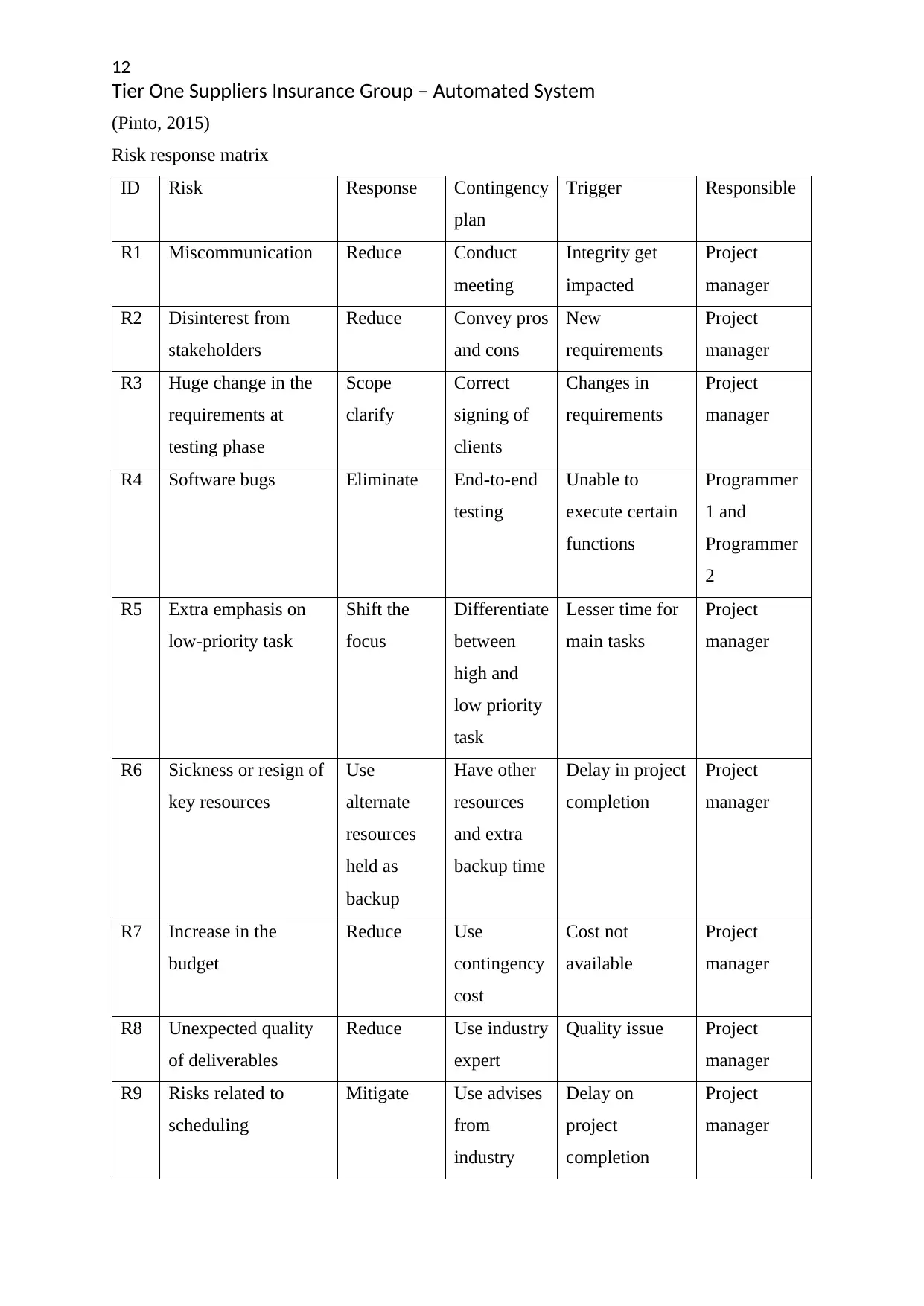
12
Tier One Suppliers Insurance Group – Automated System
(Pinto, 2015)
Risk response matrix
ID Risk Response Contingency
plan
Trigger Responsible
R1 Miscommunication Reduce Conduct
meeting
Integrity get
impacted
Project
manager
R2 Disinterest from
stakeholders
Reduce Convey pros
and cons
New
requirements
Project
manager
R3 Huge change in the
requirements at
testing phase
Scope
clarify
Correct
signing of
clients
Changes in
requirements
Project
manager
R4 Software bugs Eliminate End-to-end
testing
Unable to
execute certain
functions
Programmer
1 and
Programmer
2
R5 Extra emphasis on
low-priority task
Shift the
focus
Differentiate
between
high and
low priority
task
Lesser time for
main tasks
Project
manager
R6 Sickness or resign of
key resources
Use
alternate
resources
held as
backup
Have other
resources
and extra
backup time
Delay in project
completion
Project
manager
R7 Increase in the
budget
Reduce Use
contingency
cost
Cost not
available
Project
manager
R8 Unexpected quality
of deliverables
Reduce Use industry
expert
Quality issue Project
manager
R9 Risks related to
scheduling
Mitigate Use advises
from
industry
Delay on
project
completion
Project
manager
Tier One Suppliers Insurance Group – Automated System
(Pinto, 2015)
Risk response matrix
ID Risk Response Contingency
plan
Trigger Responsible
R1 Miscommunication Reduce Conduct
meeting
Integrity get
impacted
Project
manager
R2 Disinterest from
stakeholders
Reduce Convey pros
and cons
New
requirements
Project
manager
R3 Huge change in the
requirements at
testing phase
Scope
clarify
Correct
signing of
clients
Changes in
requirements
Project
manager
R4 Software bugs Eliminate End-to-end
testing
Unable to
execute certain
functions
Programmer
1 and
Programmer
2
R5 Extra emphasis on
low-priority task
Shift the
focus
Differentiate
between
high and
low priority
task
Lesser time for
main tasks
Project
manager
R6 Sickness or resign of
key resources
Use
alternate
resources
held as
backup
Have other
resources
and extra
backup time
Delay in project
completion
Project
manager
R7 Increase in the
budget
Reduce Use
contingency
cost
Cost not
available
Project
manager
R8 Unexpected quality
of deliverables
Reduce Use industry
expert
Quality issue Project
manager
R9 Risks related to
scheduling
Mitigate Use advises
from
industry
Delay on
project
completion
Project
manager
⊘ This is a preview!⊘
Do you want full access?
Subscribe today to unlock all pages.

Trusted by 1+ million students worldwide
1 out of 15
Related Documents
Your All-in-One AI-Powered Toolkit for Academic Success.
+13062052269
info@desklib.com
Available 24*7 on WhatsApp / Email
![[object Object]](/_next/static/media/star-bottom.7253800d.svg)
Unlock your academic potential
Copyright © 2020–2025 A2Z Services. All Rights Reserved. Developed and managed by ZUCOL.




